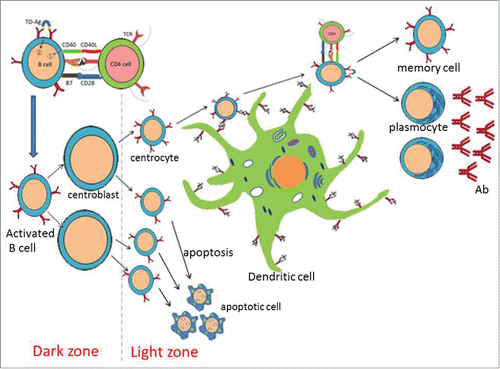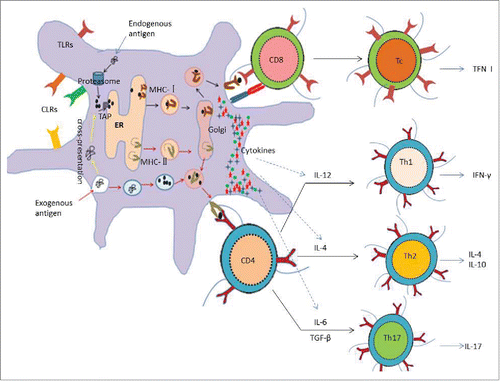Figures & data
Figure 1. B cell activation and antibody affinity maturation with DC. B cell activation needs 2 essential stimulus signals. First, BCRs recognize and combine with antigens, which produce the first stimulus signal. And the second stimulus signal is produced in the process of CD40L molecule on the Th cell membrane combining with CD40 molecule on the B cell membrane. Antibody affinity of B cells can be gradually improved by the mature process of B cells. In the germinal center of lymph nodes or spleen, centrocytes with different affinities are produced through the cell division and proliferation, then migrate to the light zone. The combination of antigens and antibodies is a dynamic equilibrium (Ag+Ab== Ag-Ab), as a consequence, centrocytes with higher affinity can combine with Ag competitively from antigen-antibody complex displayed on the surface of the DCs. With the help of Th cells, centrocytes with higher affinity can be activated to be memory cells and plasmocytes, which are able to produce antibodies of higher affinity. Whereas centrocytes with lower affinity cannot compete to the antigens, resulting in apoptosis subsequently and eliminating by macrophages.

Figure 2. Antigen processing and presentation of DCs and the activation of T cells As the professional antigen-presenting cells, DCs are able to capture, process and present both exogenous antigens and endogenous antigens. Exogenous antigens are degraded to be oligopeptides in the endocyst, and then presented by MHC-II molecules to the surface of DCs for recognization of CD4 T cells; while endogenous antigens are degraded to be oligopeptides in the cytoplasm, subsequently presented by MHC- Imolecules to the surface of DCs for recognization of CD8 T cells. CD8 T cells are activated to be CTL, which have strong ability to kill target cells through medium such as TNF, IFN-γetc. However, CD4 T cells are activated to be Th cells, which can be regulated by a variety of cytokines secreted by DCs. For example, IL-12, the main cytokine, promotes Th1 immune response, which may be inclined to the humoral immunity and secret IFN-γ; On the contrary, IL-4 promotes Th2 immune response, which may tend to the humoral immunity by secreting IL-4, IL-5, IL-10 and IL-13. In addition, IL-6 promotes Th17 immune response, which may activate neutrophils and boost the local inflammatory responses by secreting cytokines such as IL–17 and IL–22. What's more, DCs surface exists varieties of receptors such as TLRs and CLRs, which may be convenient for DC targeting.

Table 1. Ligands based DC targeted vaccines.
Table 2. Antibody based DC targeted vaccines.
Table 3. Delivery system based DC targeted vaccines.
